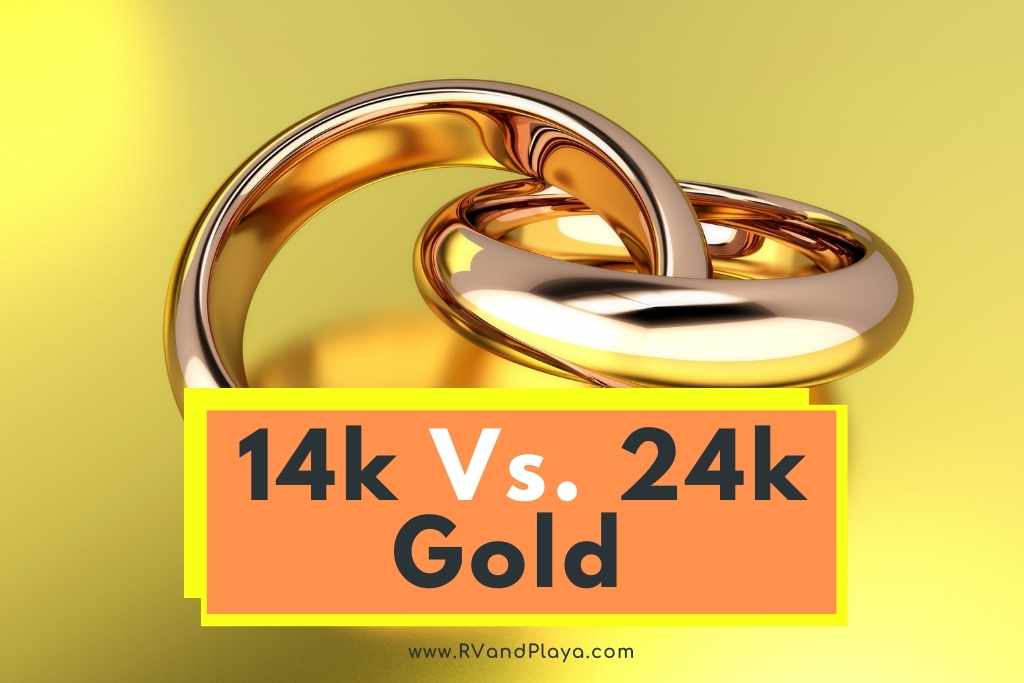Choosing the right gold and comparing 14k and 24k.
Gold is a serious business and making the right purchase can feel a little bit daunting. There is a lot of terminology and inside information that is very confusing if you don’t know all of the ins and outs.
For example, What’s The Difference Between 14K and 24K Gold? which gold is better?
This article will give you all the fine details about exactly what that “k” means, and why it might affect your decision-making, as well as other specifics that you need to know when you’re shopping for the most precious of precious metals.
Table of Contents
What Does the K Stand For?
The first thing that you will need to know when you’re looking at the difference between these kinds of gold is what that “k” actually means.
The small “k” is short for “karat”, which is a measure of the fineness of gold, and its purity. Essentially, it refers to the percentage of the metal that is actually made up of pure gold rather than metal alloys.
Basically: the higher the karat, the higher the percentage.
There is actually more than one abbreviation for the term “karat”, which all mean the same thing. It can be shortened to:
- k
- K
- Kt
- ct
Read also >> 14k Vs. 18k Rose Gold: Engagement Ring (Which Is Better?)
Read also >> Is Walmart 10k Gold Real? (Quality, Reviews + More)
Read also >> Is Walmart 14k Gold Real? (All You Need To Know)
Is Karat Different From Carat?
You might have seen the term “carat” as well and wondered whether this is referring to something different. In the terminology that is used around gold, karat and carat are just two different spellings for the same measurement.
There is a different meaning for the word “carat” though, which is where things can get a little confusing. In relation to gold, carat and karat both mean the same thing. However, when you are referring to gemstones, “carat” is a measurement of the weight of the stone, not its purity.
You can tell the difference based on what you are talking about. If it’s a gemstone: carat means weight, if it’s gold: carat means purity.
What Different Karats Can You Choose From?
Although you’ve probably heard the term 24-carat gold more than any other, there are a number of different purity measurements that you will see on gold.
A few of them are more common than any other, and they will give you an idea of the kind of purity you can expect when you see these numbers.
- 24k: 99.9% – 100% pure gold. This is the purest form of gold that you can find. It has a natural yellow color and is extremely valuable, but it is rarely used to make fine jewelry.
- 22k: 92% gold, 8% alloy metals. Also highly valuable, most often used for plain jewelry rather than combined with stones.
- 18k: 75% gold, 25% alloy metals. At this purity, the alloy metals are often used to add color, like white or rose, and it can be used for more complex pieces. This is the most traditional high-value mix.
- 14k: 58% gold, 42% alloy metals. More affordable and used for more everyday jewelry.
- 9k: 38% gold, 62% alloy metals. Much cheaper and with a paler yellow color, many fine jewelers will not sell gold pieces with a purity this low.
You can find different karat amounts out there, but these are the most common for jewelry. Most high-end retailers will stock gold between 14k and 24k, without having anything lower, but you will see lower purity at more affordable retailers.
What Is The Difference Between 24k and 14k Gold?
So, 24k gold is the purest that you can buy, while 14k is around the lowest level of gold purity that most fine jewelers will use, but how is the gold itself different?
24k Gold
24-karat gold is the most valuable, which means that it can be resold for the highest price. It also has a much stronger natural color and brightness.
This color can almost be more orange than you might think, so some people might not find it as attractive.
This purity of gold is also incredibly soft, so it is almost impossible to form intricate patterns and shapes with, and 24k pieces are very vulnerable to being scratched, bent, warped, or damaged in other ways.
You will rarely see 24k gold jewelry with stones set into it, because it is unlikely to retain its shape over time.
14k Gold
14-karat gold, on the other hand, is much more durable. It can be used to make intricate pieces and have stones set into it while still retaining its shape over time, and it is less likely to suffer damage through everyday use.
It might not be as vibrant and shiny, but it can still have a lot of the rich yellow color that people love, or the additional alloys can create other colors like white gold or rose gold.
You can find 14k gold jewelry for a much more reasonable price than anything 24k, but it does mean that it won’t have as much resale value.
Why Is Most Jewelry Not Made From Pure Gold?
It is actually quite rare to find jewelry made entirely from 24k gold, even though it is the purest and most valuable form that you can buy.
The main reason for this is its durability. Gold as a metal is incredibly soft and malleable, and while this does make it easy to shape into jewelry, it also means that it will warp and bend over time.
You would only wear 24k gold pieces on very special occasions, and even then you would have to be very cautious not to scratch or dent it.
Adding additional alloys to gold increases its durability and makes the metal much more scratch resistant.
It also allows you to make more intricate designs and delicate details because they will hold their shape.
The most common metals that are combined with gold include:
- Zinc
- Copper
- Nickel
- Iron
- Cadmium
- Aluminum
- Silver
- Platinum
- Palladium
14k vs 24k
So, why would you choose 14k over 24k, or the other way around? What are the true benefits of each of them?
Let’s break down all of the key differences between these gold varieties, and what the positives and negatives are for both.
| 14k Gold | 24k Gold |
|---|---|
| Pros Less expensive More durable Greater variety of designs and stone settings available Less likely to warp, scratch, or become damaged over time Alternative coloring options, like white or rose Cons Lower resale value Less natural brightness and gold color Potential for allergic reaction to some alloy metals | Pros Most valuable Purest form Strongest natural color Brightest shine Unlikely to cause allergic reactions Cons Highly expensive Soft and vulnerable to warping Easily scratched or damaged Not suitable for intricate designs or holding stones. |
At the end of the day, there isn’t really one option that is better than another – it’s all about what you want from your jewelry.
24k might be the most beautiful to you, and it certainly has the most value, so it could be the perfect choice for a truly special occasion or a really unique and meaningful gift.
14k can have a more interesting design, it is much more reasonably priced, and it is definitely the better choice for something that is actually going to be worn on a regular basis.
What Other Terms Are Important When You’re Shopping For Gold?
Karat isn’t everything in the gold world, and there are some other things that you need to take into consideration when you are shopping around.
- Fineness: This is similar to “karat” in that it tells you how pure a precious metal is, and it is measured in parts out of 1000. Gold with .995 fineness is 995/1000 parts pure gold.
- Alloy: Some people are allergic to metals like nickel, so it is important that you have a look at the kind of alloy being used in your jewelry.
- Gold-plated: This jewelry is not made from gold or a gold alloy. Instead, it is made from another metal with a thin gold coating layered onto the surface, which can wear off.
- Color: Generally, gold comes in natural yellow, white gold (which has a silver appearance), rose gold (a pinkish hue), and rarely green gold (with a hint of yellowish green).
James Allen is the leader in online diamond sales. Their imaging technology is the same as inspecting a diamond with a jeweler's loupe. They have the largest exclusive loose diamond inventory online and fantastic prices.
They also have the nicest collection of lab created diamonds online. Save 10% off select lab grown diamonds and 25% off ring settings during limited time sale!
WHAT WE LOVE ABOUT THEM:
- No questions asked returns within 30 days of shipment. James Allen will send you a paid shipping label to return the ring.
- Lifetime Warranty
- Free International Shipping
- Free prong tightening, repolishing, rhodium plating and cleaning every 6 months
- Provide insurance appraisals
- One free resizing within 60 days of purchase
- Free ring inscriptions
- Best-in-class high quality imagery of all diamonds in stock
- 24/7 Customer Service
- Best-in-class packaging
Conclusion
So, which one should you choose between 14k and 24k gold? It all comes down to personal preference.
24k gold is the purest and the most valuable, but it is also soft and vulnerable to damage. 14k is much more affordable and much more durable, and it is also able to hold more intricate shapes and is better for stone settings.
References
https://www.naturallycolored.com/buying-guide/10k-vs-14k-18k-24k-gold-karat-compared
https://www.britannica.com/technology/karat
Recent Posts
Gold jewelry comes with different quality levels that are typically indicated by karat. You can buy 10k all the way up to 24k gold. But what does that mean? 14k rose gold is lower quality than...
When it comes to jewelry, particularly gold, there are a number of factors involved in the pricing, based on the purity of the metal. But what makes 10k gold different from 24k gold, and are places...


